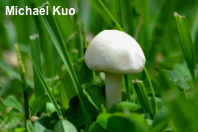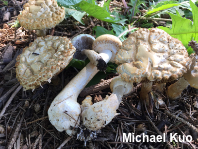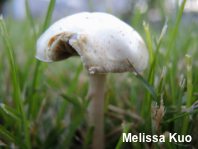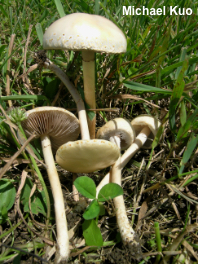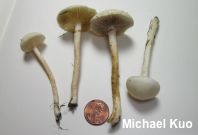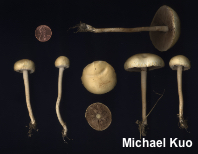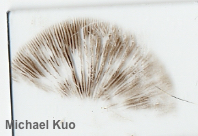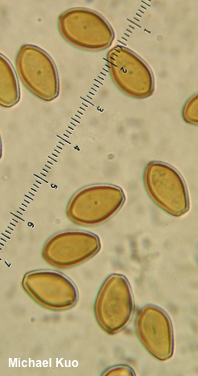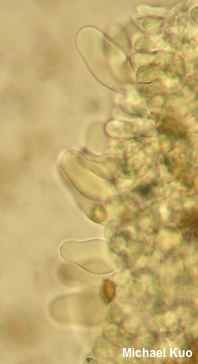| Major Groups > Gilled Mushrooms > Dark-Spored > Agrocybe & Cyclocybe > Agrocybe dura |

|
[ Basidiomycota > Agaricales > Strophariaceae > Agrocybe . . . ] Agrocybe dura by Michael Kuo, 4 July 2014 Look for Agrocybe dura in grassy areas, especially in late spring and early summer, in that painful gap between spring mushrooms and summer mushrooms, when mushroom enthusiasts in temperate climates are frothing at the bit. Agrocybe dura isn't limited to this time period, but that's when it is most likely to appear. The cap is medium-sized and more or less white, and the stem features a flimsy ring. These features will help to separate it from Agrocybe pediades, which also appears in grass but has a smaller, pale yellow-brown cap and lacks a ring. Under the microscope, Agrocybe dura features fairly large spores. Agrocybe molesta is a synonym. Thanks to Cole Furman for documenting, collecting, and preserving Agrocybe dura for study; his collection is deposited in The Herbarium of Michael Kuo. Description: Ecology: Saprobic; growing alone, scattered, or gregariously in grass (lawns, meadows, fields); sometimes appearing in fairy rings; appearing from spring through fall, but most likely to be seen in May, at least in temperate climates; originally described from Great Britain (Bolton 1788); widely distributed in Europe and North America. The illustrated and described collections are from Illinois and Missouri. Cap: 2.5–8 cm; convex at first, becoming broadly convex or nearly flat; tacky when fresh, but soon dry; bald; often becoming cracked or fissured in old age; usually whitish overall, or with a dull yellowish center—but sometimes creamy to dull yellowish overall; the margin often adorned with whitish to yellowish partial veil fibrils and remnants. Gills: Narrowly attached to the stem; close or crowded; short-gills frequent; whitish at first, becoming dull grayish brown; edges faintly whitish at maturity; at first covered by a white partial veil. Stem: 5–10 cm long and 3–15 mm thick; more or less equal; rigid; bald or a little fibrillose; whitish, sometimes discoloring brownish, especially in the bottom half; with a flimsy, ephemeral, whitish ring; basal mycelium white. Flesh: White; unchanging when sliced. Odor and Taste: Not distinctive. Chemical Reactions: KOH on cap surface negative to yellowish. Spore Print: Brown. Microscopic Features: Spores 11–16 (–19) x 6–9 (–10) µm; more or less ellipsoid, with one end flattened for a 2 –3 µm pore; smooth; walls about 1 µm thick; brownish orange to orangish-brownish in KOH; brown in Melzer's. Basidia 25–35 x 7–9 µm; clavate; 4-sterigmate. Cheilocystidia 35–60 x 10–25 µm; utriform to widely utriform; smooth; thin-walled; hyaline in KOH. Pleurocystidia 35–55 x 10–20 µm; widely utriform to clavate or sphaeropedunculate; smooth; thin-walled; hyaline in KOH. Pileipellis hymeniform but quickly deteriorating and collapsing (best seen on very young caps); hymeniform elements 15–22 x 6–10 µm; clavate to pyriform; hyaline in KOH. REFERENCES: (J. Bolton, 1788) R. Singer, 1936. (Smith, Smith & Weber, 1979; Phillips, 1981; Watling, 1982; Flynn & Miller, 1990; Phillips, 1991/2005; Lincoff, 1992; Schalkwijk-Barendsen, 1992; Breitenbach & Kränzlin, 1995; Cacialli et al., 1997; Barron, 1999; Roody, 2003; Nauta, 2005; McNeil, 2006; Miller & Miller, 2006; Boccardo et al., 2008; Buczacki et al., 2012; Kuo & Methven, 2014; Lechner, 2015; Ryman, 2018; Niveiro et al., 2020; Kibby, 2021; McKnight et al., 2021.) Herb. Kuo 06019512, 06160210, 07160301, 05090801, 05191001, 05171402, 06171503, 05131701, 05222001, 05052402. This site contains no information about the edibility or toxicity of mushrooms. |
© MushroomExpert.Com |
|
Cite this page as: Kuo, M. (2024, July). Agrocybe dura. Retrieved from the MushroomExpert.Com Web site: http://www.mushroomexpert.com/agrocybe_dura.html |
